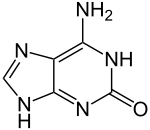 | |
| Names | |
|---|---|
| Preferred IUPAC name 6-Amino-1,9-dihydro-2H-purin-2-one | |
| Other names 2-Hydroxyadenine | |
| Identifiers | |
| CAS Number | |
| 3D model (JSmol) | |
| ChemSpider | |
| ECHA InfoCard | 100.020.144 |
| EC Number |
|
| PubChem CID | |
| UNII | |
| CompTox Dashboard (EPA) | |
InChI
| |
SMILES
| |
| Properties | |
| Chemical formula | C5H5N5O |
| Molar mass | 151.1261 |
| Except where otherwise noted, data are given for materials in their standard state (at 25 °C , 100 kPa). Infobox references | |
Isoguanine or 2-hydroxyadenine is a purine base that is an isomer of guanine. It is a product of oxidative damage to DNA and has been shown to cause mutation. It is also used in combination with isocytosine in studies of unnatural nucleic acid analogues of the normal base pairs in DNA.
It is used as a nucleobase of hachimoji nucleic acids. In hachimoji DNA, it pairs with 1-methylcytosine, while in hachimoji RNA, it pairs with isocytosine.

References
- Yang XL, Sugiyama H, Ikeda S, Saito I, Wang AH (1998). "Structural studies of a stable parallel-stranded DNA duplex incorporating isoguanine:cytosine and isocytosine:guanine basepairs by nuclear magnetic resonance spectroscopy". Biophys. J. 75 (3): 1163–1171. Bibcode:1998BpJ....75.1163Y. doi:10.1016/S0006-3495(98)74035-4. PMC 1299791. PMID 9726918.
- Andrzej Jaworski, Józef S. Kwiatkowski, Bogdan Lesyng: „Why isoguanine and isocytosine are not the components of the genetic code", International Journal of Quantum Chemistry, Supplement: Proceedings of the International Symposium on Quantum Biology and Quantum Pharmacology, 1985, 28 (Supplement S12), pp. 209–216 (doi:10.1002/qua.560280720).
- Christopher Roberts, Rajanikanth Bandaru, Christopher Switzer: „Theoretical and Experimental Study of Isoguanine and Isocytosine: Base Pairing in an Expanded Genetic System", J. Am. Chem. Soc., 1997, 119 (20), pp. 4640–4649 (doi:10.1021/ja970123s).
- Hoshika, Shuichi; et al. (22 February 2019). "Hachimoji DNA and RNA: A genetic system with eight building blocks". Science. 363 (6429): 884–887. Bibcode:2019Sci...363..884H. doi:10.1126/science.aat0971. PMC 6413494. PMID 30792304.
This article about an organic compound is a stub. You can help Misplaced Pages by expanding it. |